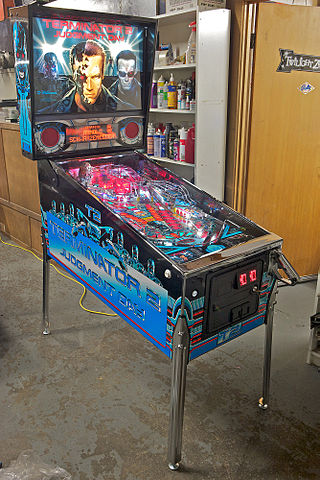
Pinball games are a family of games in which a ball is propelled into a specially designed table where it bounces off various obstacles, scoring points either en route or when it comes to rest. Historically the board was studded with nails called 'pins' and had hollows or pockets which scored points if the ball came to rest in them. Today, pinball is most commonly an arcade game in which the ball is fired into a specially designed cabinet known as a pinball machine, hitting various lights, bumpers, ramps, and other targets depending on its design. The game's object is generally to score as many points as possible by hitting these targets and making various shots with flippers before the ball is lost. Most pinball machines use one ball per turn, and the game ends when the ball(s) from the last turn are lost. The biggest pinball machine manufacturers historically include Bally Manufacturing, Gottlieb, Williams Electronics and Stern Pinball.
Stern is the name of two different but related arcade gaming companies. Stern Electronics, Inc. manufactured arcade video games and pinball machines from 1977 until 1985, and was best known for Berzerk. Stern Pinball, Inc., founded in 1986 as Data East Pinball, is a manufacturer of pinball machines in North America.
A glossary of terms, commonly used in discussing pinball machines.

Black Hole is a pinball game released in 1981 by Gottlieb. It is notable for having two playfields: one on top with a conventional slope, and one mounted underneath, sloping away from the player. It has no connection with the 1979 film of the same name.
Patrick M. Lawlor is a video game and pinball machine designer.
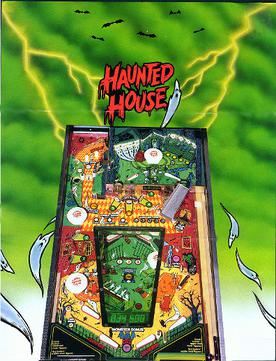
Haunted House is a pinball game released in October 31 1982 by Gottlieb. It was the first game with three playfields that the ball can move between, including one below the main playing surface. Haunted House was designed by John Osborne, with artwork by Terry Doerzaph. It is part of Gottlieb’s “System 80” series of pinball machines.
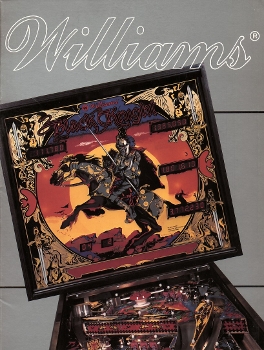
Black Knight is a 1980 pinball machine designed by Steve Ritchie and released by Williams Electronics. Ritchie designed two sequels: Black Knight 2000, released by Williams in 1989, and Black Knight: Sword of Rage, released by Stern Pinball in 2019.
There have been four pinball adaptations of the film Jurassic Park franchise: a physical table released by Data East the same year the film came out, Sega's 1997 The Lost World which is based on the second movie of the series, a virtual table developed by Zen Studios on the franchise's 25th anniversary and a new physical table released by Stern Pinball a year after. All four tables behave differently.
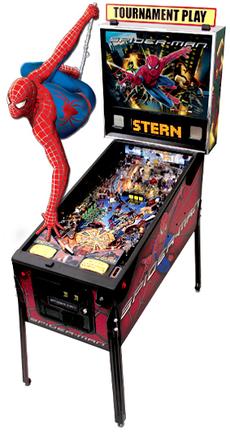
Spider-Man is a pinball machine designed by Steve Ritchie and manufactured by Stern Pinball that was first released in June 2007. The table encompasses all three films in Sam Raimi's Spider-Man trilogy, which in turn were based on the prior comics and television series.

Whirlwind is a pinball machine produced by Williams in 1990 and was one of the last Williams System 11b games. It was designed by Pat Lawlor, who created a previous natural disaster-themed pinball for Williams, Earthshaker!.
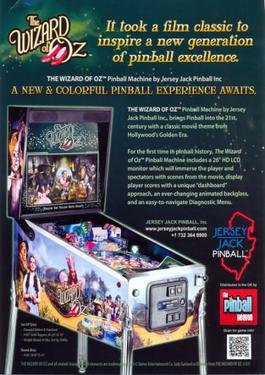
The Wizard of Oz is a Jersey Jack Pinball, Inc. pinball machine designed by Joe Balcer and released in April 2013. It is the first US pinball machine with an LCD in the back box as well as the first one to have color on the monitor produced in the US since the Pinball 2000 games. Although it is not the first pinball machine with a LCD worldwide because MarsaPlay in Spain manufactured a remake of Inder's original Canasta titled New Canasta, with an LCD screen in the backbox in 2010.

Tee'd Off is a pinball machine designed by Ray Tanzer and Jon Norris and released by Gottlieb in May 1993.

Zaccaria, was an Italian company of pinball and arcade machines that existed in Bologna from 1974 until 1990. The factory was sold to tecnoplay.

Harley-Davidson is a Sega Pinball pinball machine released in September 1999 and was the last machine released by this company. It was designed by Jon Borg and Lonnie D. Ropp.

Taito of Brazil was a pinball and arcade manufacturer located in São Paulo, Brazil. The company originally started out as Clover Electronic Amusement in 1968, then became Taito of Brazil in 1972 by Abraham "Abba" Kogan, the son of the founder of the parent company Taito located in Japan. This subsidiary was originally an importer of existing U.S. and Japanese machine components to be assembled within the country. However, the taxation on imports had been growing steadily, and the government's belief that pinball is a game of chance and considered a gambling machine, led to strict import rules. By 1976, within rules created by the Electronic Processing Activities Coordinating Committee (CAPRE), it became illegal to import pinball machines. This created a problem, since the popularity of arcade games in Brazil had been growing exponentially for many years.

Genie is a widebody pinball machine designed by Ed Krynski and released in 1979 by Gottlieb. It features a jinn theme and was advertised with the slogans "Gottlieb's WIDE and Beautiful BODY" and "A Wide-Body Pinball absolutely bulging with player appeal and proven massive profit earning capacity!".

Spirit of 76 is a pinball game designed by Ed Krynski and Wayne Neyens and released in 1975 by Gottlieb. The pinball machine should not be confused with the pinball machine The Spirit of '76 by Mirco Games, Inc.

The Champion Pub is a pinball game released by Williams Electronics Games in 1998. The theme of the game revolves around boxing in a 1920s pub.
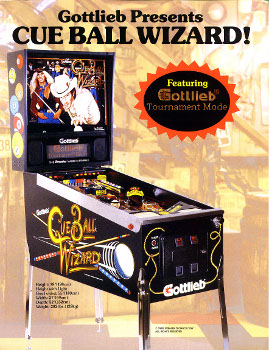
Cue Ball Wizard is a pinball machine designed by Jon Norris and released in December 18 1992 by Gottlieb. It features a cue sports theme and was advertised with the slogan "Gottlieb Presents CUE BALL WIZARD!".

The Phantom of the Opera is a pinball machine released by Data East in 1990. The game is based on the 1910 French novel The Phantom of the Opera by Gaston Leroux, but not based on the 1986 musical by Andrew Lloyd Webber or movie of the same name, although released around the same time. The game was designed by Joe Kaminkow and Ed Cebula.
















